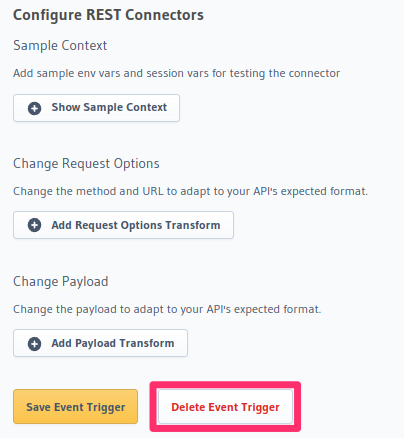Remove Event Triggers
Removing Event Triggers
Event Triggers can be removed using the Hasura Console, Hasura CLI, or Metadata APIs.
- Console
- CLI
- API
Open the Hasura Console, head to the Events tab, click on the Event Trigger you want to delete, and click on the
Delete Event Trigger button at the bottom of the page:

You can remove an Event Trigger for a table by updating the databases > [source-name] > tables > [table-name].yaml file
inside the metadata directory and removing the event trigger from it:
- table:
schema: public
name: author
event_triggers:
- name: author_trigger
definition:
enable_manual: false
insert:
columns: "*"
update:
columns: "*"
webhook: https://httpbin.org/post
Apply the Metadata by running:
hasura metadata apply
You can delete Event Triggers by using the appropriate Metadata API, either: pg_delete_event_trigger or mssql_delete_event_trigger.
To delete an Event Trigger via the the Metadata API, replace <db_type_delete_event_trigger> with the following:
- Postgres:
pg_delete_event_trigger - MSSQL:
mssql_delete_event_trigger
POST /v1/metadata HTTP/1.1
Content-Type: application/json
X-Hasura-Role: admin
{
"type" : "<db_type_delete_event_trigger>",
"args" : {
"name": "author_trigger",
"source": "default"
}
}
Event Triggers for a table or source will also get dropped if the corresponding table/source is dropped.
An Event Trigger can be removed using the above methods (Delete Event Trigger, Drop Table or Drop Source) only when the metadata is consistent.
If the metadata is inconsistent, then an Event Trigger can be dropped using "Replace Metadata" or "Clear Metadata" methods. This may leave some footprint in the source which can be cleaned manually as described in the following section.
Clean up Event Trigger footprints manually
When an Event Trigger is created, Hasura creates SQL triggers on the table corresponding to each database operation
(INSERT/UPDATE/DELETE) described in the Event Trigger configuration.
When an inconsistent Table/Event Trigger is removed via the replace_metadata API, it may leave orphaned SQL triggers
in the database. The following command can be used to manually delete SQL triggers corresponding to an Event Trigger on
a table:
DROP FUNCTION hdb_catalog."notify_hasura_<event-trigger-name>_<OPERATION-NAME>" CASCADE;
For example: to delete SQL triggers corresponding to an Event Trigger: users_all on a table: users with operation:
INSERT in the Event Trigger configuration:
DROP FUNCTION hdb_catalog."notify_hasura_users_all_INSERT" CASCADE;
The SQL trigger should be deleted for each operation mentioned in the Event Trigger configuration, i.e.
INSERT/UPDATE/DELETE
Clean up Hasura footprints from a source manually
When a source in an inconsistent state is dropped, it may leave Hasura footprints in the database due to Event Triggers. The following can be used to remove all footprints of Event Triggers present in a source from the database:
Case 1: When using a different Metadata database to the source database
In this case, hdb_metadata table is not present in hdb_catalog schema of the source.
To clean up Hasura footprint completely, drop the hdb_catalog schema:
DROP SCHEMA IF EXISTS hdb_catalog;
Case 2: When the Metadata database and source database are the same
In this case, a hdb_metadata table is present in the hdb_catalog schema of the source. You may want to preserve the
Metadata but remove the remaining Hasura footprint of a few tables for Event Triggers and corresponding SQL triggers.
Step 1: In order to drop the SQL triggers corresponding to Event Triggers created, please refer to the clean up Event Trigger footprints manually section. Alternatively, the following command can be used to drop all SQL triggers in the source:
do $$
declare f record;
begin
for f in select trigger_name, event_object_table
from information_schema.triggers
where trigger_name like 'notify_hasura_%'
loop
EXECUTE 'DROP FUNCTION hdb_catalog.' || QUOTE_IDENT(f.trigger_name) || ' CASCADE';
end loop;
end;
$$;
Step 2: The following commands can be used to delete Event Triggers tables from hdb_catalog:
DROP TABLE IF EXISTS hdb_catalog.hdb_source_catalog_version;
DROP FUNCTION IF EXISTS hdb_catalog.insert_event_log(text, text, text, text, json);
DROP TABLE IF EXISTS hdb_catalog.event_invocation_logs;
DROP TABLE IF EXISTS hdb_catalog.event_log;
DROP TABLE IF EXISTS hdb_catalog.hdb_event_log_cleanups;
It is recommended to perform the above steps in a single transaction.